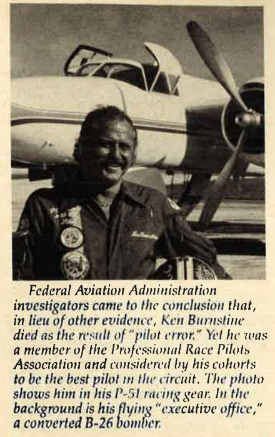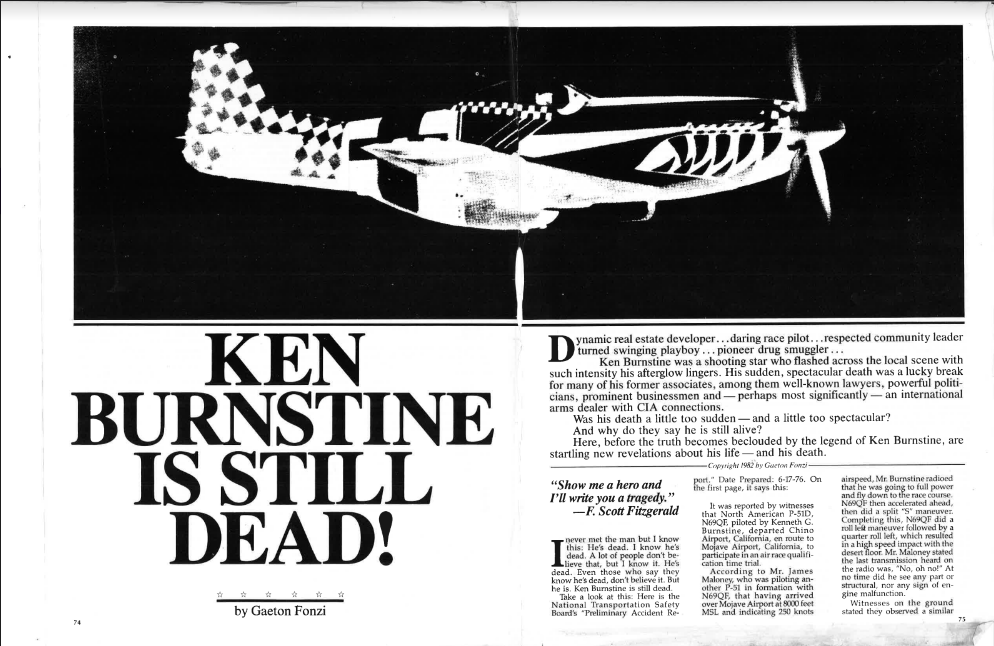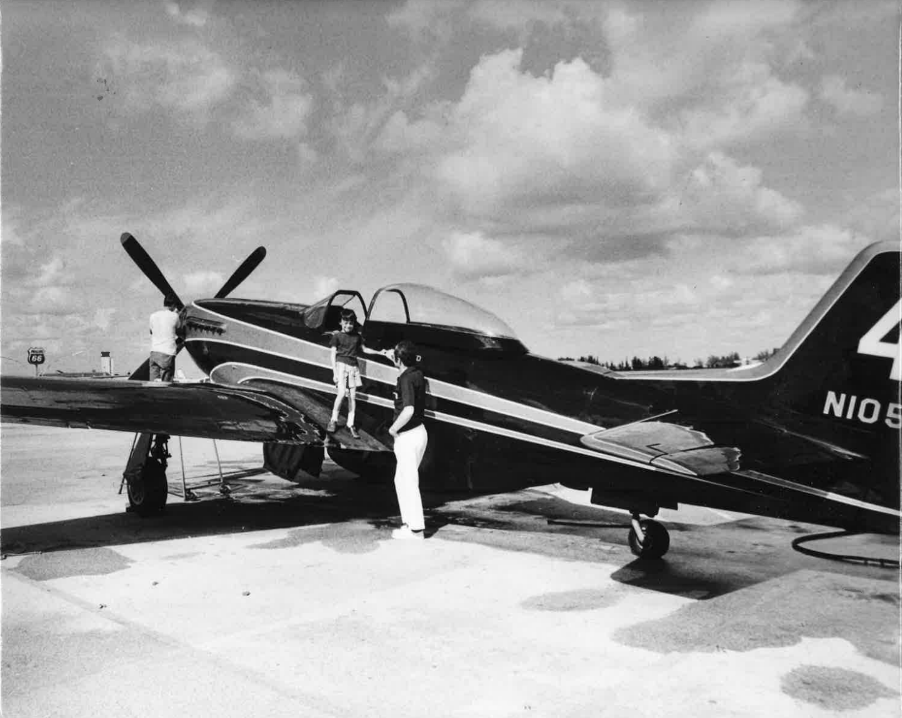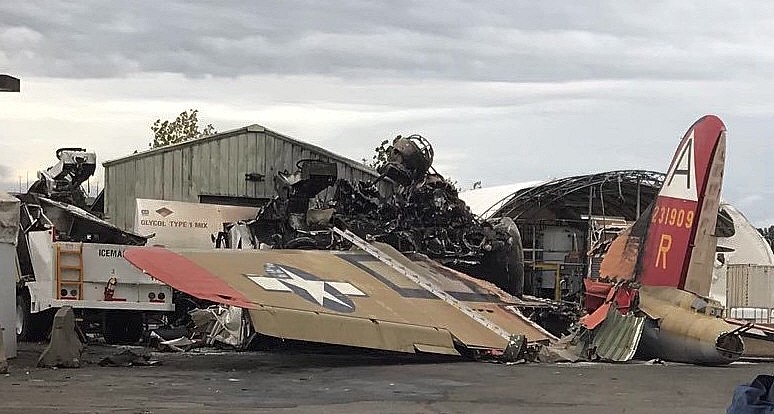"Masters of the Air" Planes Hit Home
"Masters of the Air," the docudrama recalling the remarkable story of the first heavy bomber units to attack the Germans in World War Two, has saluted the pilots and their planes which took terrible losses before ultimately prevailing over the Luftwaffe's formidable defenses. The series, which ends this week, has been extensively promoted on the internet and has generated interest in the airplanes involved. Most prominent are the Boeing B-17 bomber, nicknamed the Flying Fortress, which pioneered dangerous daylight bombing in 1943, and the North American P-51 Mustang, the fighter which was vital in neutralizing the German fighter planes in 1944 and 1945.
Those two aircrafts, oddly enough, both touched our former magazine, Gold Coast, in curious ways. Covering these tales chronologically, we go back to the 1970s. The P-51 had been preserved in larger numbers than most warbirds, serving for years with several foreign air forces. It also enjoyed a second career as an air racer. A prime example of the Mustang was based in Broward County, owned and raced by a notorious character named Ken Burnstine. Burnstine was an Ivy League-educated developer and accomplished pilot who owned and raced a colorfully painted P-51. He was the essence of flamboyance in his personal life. He gloried in publicity of any kind. Among other attention-getting activities he kept a pet lion in his Coral Ridge home. He also had developed a second career as a drug runner. Planes he owned crashed loaded with dope flown in from the islands and Central America. He always claimed the aircrafts were leased and he had nothing to do with drug running. Nobody believed him, including the police, and people wondered why he was not arrested.

Our magazine helped spread his legend when we featured his P-51 on our cover in 1975 during a general fuel shortage. Margaret Walker, our veteran associate editor, was appalled that we would feature such an unsavory character in a magazine which still was identified with social coverage of people dancing for disease. But the story got a lot of interest, for many of our readers knew Burnstine. But they did not know him long. In 1976, he died when his air racer crashed while practicing for a race in California. The plane burned out and a common reaction was "Oh, that beautiful airplane." Such was Burnstine's reputation that over the next few years, rumors spread that he had faked his death to avoid prosecution for drug running. It was reported that only a thumb was found in the crash and that he had been spotted living the good life in Europe.
At the time, Burnstine had been arrested but was avoiding prosecution by working as an informant for the feds. It was suspected he was running guns south for our government to support covert activities in various countries. In return, he was allowed to keep his drug-running operation on the trip home. That cozy arrangement was about to end, however, for Burnstine had implicated a number of local people, some prominent, in funding his drug operation. The government was about to move when their star witness died in the crash.
All this intrigued Gaeton Fonzi, our partner who had an instinct for stories behind the story. In 1981, he contacted California authorities and learned they were puzzled by all the rumors of Burnstine surviving the crash. His whole body was found in the wreckage, not just a thumb. Fonzi also learned that people at the airfield where he died found the circumstances of the crash suspicious. Burnstine was known to indulge his show-off tendencies upon takeoff by rolling his plane as soon as he gained enough altitude. When he did so that day, he cried out suddenly and his plane plunged out of control into the ground. Observers thought something happened in the cockpit to cause him to lose control. One theory was that a motion-activated bomb went off as soon as he started his maneuver. That bomb would burn out and leave no trace behind. His plane had been untended the night before and someone could have planted the bomb without being seen. In short, Fonzi concluded, he might have been murdered. There were certainly enough people who would want him dead before he could testify against them. At the least, Fonzi put to bed the nonsense about Burnstine living the good life in Europe.

Gaeton Fonzi's investigation led to a three-part series in 1981. It was one of the best-read stories in the magazine's history.
Our encounter with the B-17 came much later. In 2005, we got an invitation to take a press ride on a touring B-17. We accepted, of course, and took a brief (about 10 minutes) hop from Stuart to Vero Beach. We got to tour the plane. Our best memory is before takeoff we sat near the tail and watched Ernest "Mac" McCauley operate the tail wheel manually. A young woman was at the controls that day and McCauley seemed disturbed. "That girl will wreck this plane," he muttered. McCauley himself was the usual pilot, and with years on the job, was called the most experienced B-17 jockey in the world. It is beyond irony therefore that in 2019 the same plane crashed during a demonstration at Bradley International Airport in Connecticut. An engine failed on takeoff, and the plane did not make the runway when trying to return. Seven of 13 aboard died in a crash landing, including the pilot. An investigation blamed pilot error for the tragedy. The plane lost speed on its landing approach because the wheels were lowered too soon and created drag. The pilot was Mac McCauley, the most experienced B-17 pilot in the world.

The magazine did several stories on wealthy owners of vintage planes. Eight-year-old Mark McCormick and his father Bernard posed with this P-51 in Miami in 1974.

The remains of the B-17 the author flew in 13 years before this crash in Connecticut.

Boca Raton Army Air Field
This Comment had been Posted by Sally J. Ling
Bernie, nice article. I wrote a book in 2005 (Small Town, Big Secrets) that also deals with B-17, B-24, etc. that were based at the Boca Raton Army Air Field (1942-1947). If you haven't seen the documentary "The Secret Weapon that Won WWII" based upon the book and produced by WLRN you should. It is the profound story of this top-secret military installation and its vital role in winning WWII. Secret missions from England to the US by scientists and top military brass, a clandestine research lab at MIT (Rad Lab) that perfected the cavity magnetron to eventually become airborne radar, hush-hush radar training BRAAF that resulted in a court martial if the word 'radar' was mentioned out of the classroom. Then, of course, there was the installation and maintenance of the device in the planes at BRAAF. The unofficial slogan of those working in the Rad Lab was "Radar won the war, the bomb ended it." This is a story that few know, and no one ever talked about. The Boca Raton Historical Society and Museum is showing the documentary at their facility this month. I hope you'll take a ride up there and see it. You'll become mesmerized by such a surprising story, one that happened in our back yard. Blessings, Sally J. Ling
War Story
This Comment had been Posted by tom mc gill
Brings to mind VJ Day in Aug. 1945 when at the age of eight and in Sea Isle City, NJ, I witnessed Church Bells tolling, cars moving about with metal garbage cans tied to there bumpers, and people flocking to St Joseph's Church.